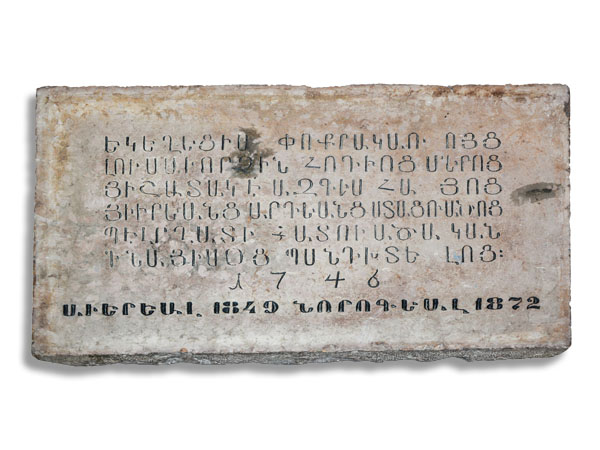Title:
The board of the Armenian church facade
English
Description:
A marble plaque of the Armenian Church facade is the only material left of the first temple of Armenians in Novi Sad, built in 1746. The board survived the bombing of the city in 1849 and was re-built in the street facade of the restored temple in 1872. The inscription on it is carved in Armenian language. The exhibit is a part of the exhibition "Armenian Church in Novi Sad - deleted heritage," by the author Ljiljana Lazic, art historian and museum counselor.
Place of origin of the cult. artefact:
Novi Sad
State of origin of the cult. artefact:
Serbia
History:
In October 1963, in Novi Sad, St.George the Enlightener, popularly called the Armenian Church was demolished. For more than two centuries, this temple has witnessed the efforts of its believers and priests to build, maintain, restore and preserve. Unfortunately, in the decades after World War II, it shared the fate of the Armenians vanished from Novi Sad. Demolition of the Armenian Church is a non-volatile error in the post-war urban planning of Novi Sad. Part of the old center of the city, whose urban pattern was established in the early 18th century, has been sacrificed to the modern architecture and the new junction. In the clash of old and new, the church has been characterized as a "worthless piece of architecture," whose existence is not necessary. Generations of citizens of Novi Sad were also deprived of a part of heritage, unique in its cultural, religious and architectural significance. Of the life and last years of the existence of the Armenian Church and its small community extensive archival, documentary and photographic material, which reveals all the circumstances that led to the tragic and unnecessary demolition, remained preserved. Part of the precious legacy of the church is now kept in the Museum of the City of Novi Sad, and, after half a century, testifies to the former appearance of the Church of St.. George the Enlightener.
Copyright:
City Museum of Novi Sad
Creator:
Srdjan Veselinov
Material:
Type of cultural artefact:
Formats of digital document:
Images:

Власник записа:
srdjan.veselinov
Year of creation:
1746
Name of the original:
Плоча са фасаде Јерменске цркве
Municipality:
Novi Sad
Region:
Vojvodina
Country:
Serbia
Institution:
Religion:
Period:
